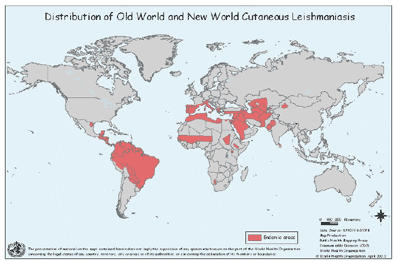350 million people at risk worldwide and 1.5 million new cases annually
An international collaboration of researchers from the U.S. Army Medical Research and Materiel Command (USAMRMC), Tunisia and France has demonstrated a high cure rate and remarkably few side effects in treating patients with cutaneous leishmaniasis (CL) with an investigational antibiotic cream. CL is a parasitic disease that causes disfiguring lesions, with 350 million people at risk worldwide and 1.5 million new cases annually, including U.S. military personnel serving abroad and the socio-economically disadvantaged in the developing world, especially children. The results of the research conducted by USAMRMC, the Institut Pasteur de Tunis, the Tunisian Ministry of Health and the Institut Pasteur in Paris were published today in the New England Journal of Medicine.
“A simple cream represents a tremendous breakthrough in the way we treat this neglected disease,” said Maj. Mara Kreishman-Deitrick, product manager at the U.S. Army Medical Materiel Development Activity, which leads the advanced development of medical products for the USAMRMC. “Currently, patients must stay in a medical center for weeks to receive toxic and painful treatments. A cream would offer a safe, effective option that patients can apply themselves.”
Phase III study investigators evaluated WR 279,396, a combination of two antibiotics (15 percent paromomycin-0.5 percent gentamicin). In the trial, the topical cream cured the CL lesions in 81 percent of the patients who participated in the clinical trial. Curing the disease was defined as the shrinking of the lesion, regrowth of normal skin and absence of relapse. Adverse events were reported in less than 5 percent of all study groups and were primarily reported as minor reactions at the application site.
A cream containing paromomycin alone (15 percent paromomycin) had a similar cure rate of 82 percent. In the study, only 58 percent of the patients who received a vehicle cream not including antibiotics or other active ingredients saw the lesions cured.
Researchers said they expected parity between the single and combination therapies in this study, which treated CL caused by L. major, a parasitic species common in the Middle East and North Africa. However, they noted that the combination therapy could hold additional promise for global use since early research shows the combination therapy may be effective against the parasitic species found in Central and South America.
The 375-patient trial was sponsored by the USAMRMC and was conducted in partnership with the Tunisian Ministry of Health, the Institut Pasteur in Tunis and the Institut Pasteur in Paris.
Current CL treatments called antimonials contain toxic heavy metals that must be administered either intravenously or injected directly into the lesion. Because of toxicity, many health care providers are hesitant to use them to treat the disease. People who have CL must leave home and work to undergo the standard 20-day course of treatment at a medical center. Public health workers in the developing world see patients resort to home treatments like burning their lesions with battery acid or red-hot machetes, rather than seek out painful and expensive medical treatments. These home remedies also can compound the severity of scarring.
More than 3,000 CL cases have been reported among U.S. service members since 2003. Service members who develop CL often must be evacuated from their posts – at an approximate cost of $35,000 for hospitalization, treatment and lost duty time per service member. WR 279,396 has the potential to become a first-line treatment that service members could apply themselves in the field.
“The research community has tended to overlook CL because it is not deadly, but that doesn’t mean the disease does not have a lifelong impact on patients,” said Professor Afif Ben Salah, principal investigator for the Tunisia study and head of the Medical Epidemiology Department at the Institut Pasteur in Tunis. “Many people experience discrimination in social settings, at work or at school as a result of the disease’s devastating scarring. The stigma takes a serious toll on their education, marriage and employment prospects.”
via US Army Medical Research Institute of Infectious Diseases & EurekAlert
The Latest Streaming News: Cutaneous leishmaniasis updated minute-by-minute
Bookmark this page and come back often
Latest NEWS
Latest VIDEO









